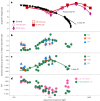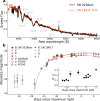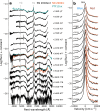Newly formed dust within the circumstellar environment of SN Ia-CSM 2018evt
- PMID: 38659610
- PMCID: PMC11035149
- DOI: 10.1038/s41550-024-02197-9
Newly formed dust within the circumstellar environment of SN Ia-CSM 2018evt
Abstract
Dust associated with various stellar sources in galaxies at all cosmic epochs remains a controversial topic, particularly whether supernovae play an important role in dust production. We report evidence of dust formation in the cold, dense shell behind the ejecta-circumstellar medium (CSM) interaction in the Type Ia-CSM supernova (SN) 2018evt three years after the explosion, characterized by a rise in mid-infrared emission accompanied by an accelerated decline in the optical radiation of the SN. Such a dust-formation picture is also corroborated by the concurrent evolution of the profiles of the Hα emission line. Our model suggests enhanced CSM dust concentration at increasing distances from the SN as compared to what can be expected from the density profile of the mass loss from a steady stellar wind. By the time of the last mid-infrared observations at day +1,041, a total amount of 1.2 ± 0.2 × 10-2 M⊙ of new dust has been formed by SN 2018evt, making SN 2018evt one of the most prolific dust factories among supernovae with evidence of dust formation. The unprecedented witness of the intense production procedure of dust may shed light on the perceptions of dust formation in cosmic history.
Keywords: Astrophysical dust; Time-domain astronomy.
© The Author(s) 2024.
Conflict of interest statement
Competing interestsThe authors declare no competing interests.
Figures













References
-
- Morgan HL, Edmunds MG. Dust formation in early galaxies. Mon. Not. R. Astron. Soc. 2003;343:427–442.
-
- Matsuura M, et al. The global gas and dust budget of the Large Magellanic Cloud: AGB stars and supernovae, and the impact on the ISM evolution. Mon. Not. R. Astron. Soc. 2009;396:918–934.
-
- Hoflich, P., Khokhlov, A. & Wheeler, C. in From Gas to Stars to Dust, Vol. 73 (eds Haas, M. R. et al.) Ch. 57 (Astronomical Society of the Pacific, 1995).
-
- Ferrara A, Peroux C. Late-time cosmic evolution of dust: solving the puzzle. Mon. Not. R. Astron. Soc. 2021;503:4537–4543.
-
- Rho J, et al. Freshly formed dust in the Cassiopeia A supernova remnant as revealed by the Spitzer space telescope. Astrophys. J. 2008;673:271–282.
LinkOut - more resources
Full Text Sources
